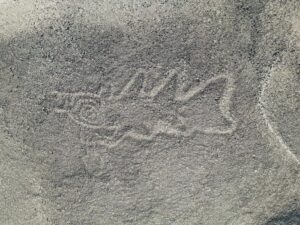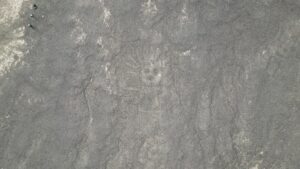
Proceedings of the National Academy of Sciences—An AI-assisted analysis nearly doubles the number of known Nazca geoglyphs, revealing the forms, locations, and potential uses of the geoglyphs, according to a study. Nazca geoglyphs are figures on the ground created by moving stones or gravel. Field surveys that began in the 1940s have identified 430 figurative geoglyphs of motifs such as animals and humans. Masato Sakai, Marcus Freitag, and colleagues applied AI image analysis to high-resolution images of the entire Nazca region of Peru to accelerate the rate of geoglyph discovery. The authors identified an additional 303 geoglyphs within six months of field survey. The AI-based system was skillful in identifying relief-type geoglyphs, which are smaller and more difficult to identify than large, line-type geoglyphs. Next, the authors analyzed the geoglyphs’ form, location, and probable use. Among relief-type geoglyphs, 81.6% depicted domestic animals or humans, whereas 64% of line-type geoglyphs depicted wild animals. Relief-type geoglyphs were built within viewing distance—on average 43 meters—from foot trails. Line-type geoglyphs were built an average of 34 meters from a linear network of geoglyphs. According to the authors, relief-type geoglyphs may have been used to convey cultural concepts, including those related to domesticated animals or human sacrifice, to individuals or small groups walking along trails, whereas line-type geoglyphs may have been part of community-level ritual activities.
______________________________

A 22-meter-long relief-type geoglyph depicting a killer whale holding a knife. Masato Sakai
______________________________

A 18-meter-long relief-type geoglyph depicting a human. Masato Sakai
______________________________
Article Source: PNAS news release.
*“AI-accelerated Nazca survey nearly doubles number of known figurative geoglyphs and sheds light on their purpose,” by Masato Sakai et al., Proceedings of the National Academy of Sciences, 23-Sep-2024. https://www.pnas.org/cgi/doi/10.1073/pnas.2407652121
______________________________
Advertisement

EXPLORE THE ANCIENT ETRUSCANS IN PERSON!
Experience a unique, up-close-and-personal hike among ancient hilltop towns in central Italy. You will walk the sensational countryside of the regions of Umbria and Tuscany, soaking in important sites attesting to the advanced Etruscan civilization, forerunners of the ancient Romans; imposing architectural and cultural remains of Medieval Italy; local food and drink; and perhaps best of all — spectacular scenic views! Join us in this collaborative event for the trip of a lifetime!


